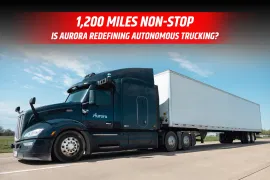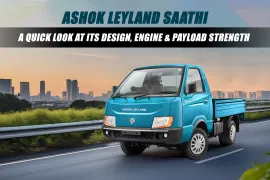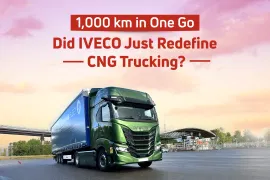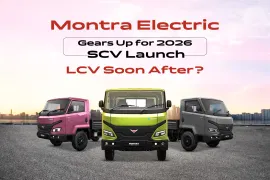Trucks are what India runs on. They move grain, steel, cement, and completed items every day. Without them, markets would run out of goods and warehouses would stop working. But the market for trucks in India is not the same everywhere. Things that sell well in Punjab don't always sell well in Tamil Nadu. What works on the highways in Rajasthan doesn't necessarily work on the mountainous roads in Kerala.
Trucks from North India and South India go various ways. Those pathways are shaped by geography, industry, and trading habits. They all illustrate why trends in regional trucks are important to the market for commercial vehicles.
India's Truck Market: One Country, Many Markets
There are a lot of businesses that use trucks. It has everything from modest three-tonne vehicles to large 55-tonne trucks and everything in between. But figures don't tell the whole story.
- In the north, trucks carry stone, cement, and grain over long roadways.
- In the south, vehicles move containers, IT equipment, and agricultural goods across shorter, more crowded routes.
This difference illustrates that the commercial vehicle market in India is really regional, not national.
North India: Made to Carry Heavy Loads
Trucking goes with scale in the north. Punjab, Haryana, Uttar Pradesh, Delhi, and Rajasthan make up a strip of land where farming and building are the most important things. Fleets here commonly use heavy-duty trucks on roadways that go for hundreds of kilometers.
What makes Northern Demand happen
- Agriculture at Scale: Punjab and Haryana grow wheat and rice on a large scale and send it to the national reserves. Crops go in bulk, and only big fleets can meet deadlines.
- Mining and Construction: Rajasthan mines marble and sandstone. Delhi-NCR is always creating new highways, metro lines, and homes. Tipper trucks and multi-axle trucks are needed in both fields.
- Corridor Trade: The Delhi–Mumbai Industrial Corridor and highways like NH-44 move iron, cement, and machinery across states.
Trucking Characteristics in the North
- Trucks with more than one axle and trailers are still the most common.
- Even if gasoline prices are going up, diesel engines still give you torque when you need it.
- Transport businesses frequently have fleets of 50 to 200 vehicles, which gives them an edge in terms of scale.
- More and more people are using digital technology. GPS, route planning, and telematics all help save fuel.
So, the north operates on volume. In the trucking world, distance, load capacity, and operating size are all very important.
South India: Put Efficiency First
Trucking changes to fit different needs in the south. There are IT hubs, manufacturing factories, and plantations in Tamil Nadu, Karnataka, Telangana, Andhra Pradesh, and Kerala. Fleets appear different here. They use light and medium trucks more commonly to serve ports and city networks.
Reasons for Southern Demand
- Urban Economies: Bengaluru, Chennai, and Hyderabad depend on delivery vehicles for both retail and online shopping.
- Port Logistics: Trucks are always moving between the ports of Chennai, Kochi, and Visakhapatnam. Every day, containers migrate further inland.
- Plantations and Crops: Tea, coffee, bananas, and spices need to be able to move easily between farms and towns.
Things to Know About Trucking in the South
- People like light commercial vehicles (LCVs) and intermediate trucks (ICVs) the most.
- Since operators are in very competitive marketplaces, fuel efficiency is the most important thing.
- State measures help CNG, LNG, and electric trucks become more popular.
- There are a lot of different owners; small businesses usually have 3 to 10 automobiles each.
In this case, being flexible is more important than size. Fleets want to find a balance between the expense of running and the amount of cargo they can carry.
North vs South: A Direct Comparison
| Factor | North India Trucks | South India Trucks |
| Truck Size | Heavy-duty, multi-axle | Light and medium |
| Primary Use | Long-haul, bulk cargo | Short-haul, urban logistics |
| Fuel Choice | Mostly diesel | Mix of diesel, CNG, LNG, EV |
| Ownership | Large fleets dominate | Small operators dominate |
| Market Drivers | Agriculture, mining, highways | Ports, IT, plantations |
Effects on Truck Sales in India
These trends have a direct effect on truck sales in India. OEMs change their plans from one region to the next.
- Tata Motors, Ashok Leyland, and BharatBenz all sell heavy-duty vehicles with bigger payloads and stronger engines in the north.
- Manufacturers in the south focus on small trucks, good mileage, and cheap operating costs. Ashok Leyland and Eicher, in particular, do well in this area because they provide a lot of LCVs.
Both areas help keep the market for commercial trucks in balance. Heavy trucks go up in one area, while efficient trucks go up in another.
The Economics of Fleet and the Drivers' Point of View
Regional patterns also have an effect on how drivers and operators do their jobs.
- North fleets make money based on distance and tonnage. On excursions that last more than one day, drivers routinely go 800 to 1,000 kilometers.
- South fleets make money by being flexible and frequent. Drivers take shorter journeys but make more rotations in a week.
The costs of running the business are also different. In the north, diesel is the most common fuel because there aren't many CNG stations. In the south, CNG and LNG help operators save money, and some early adopters are even testing electric vehicles.
Emerging Trends Across Regions
Change is changing both markets:
- Green Mobility: More and more LNG and electric trucks are on the road around the country. The southern states are ahead in adoption because they have better policy support.
- Digital Fleet Tools: Telematics, GPS tracking, and predictive maintenance help operators save money. More people are adopting in major northern fleets, but it's creeping south.
- Financing Models: Companies in the North use bulk loans. Microfinance, non-banking financial companies (NBFCs), and cooperative lending are common ways for southern operators to get money.
Final Thoughts
The regional truck trends in India show how the economy and geography affect the need for transportation. Trucks in North India are big, travel long distances, and carry hefty loads. Trucks from South India show that they are efficient, flexible, and make greener choices. Truck builders need to change their plans. Policymakers need to encourage the strengths of each region. The market for commercial vehicles in India is still varied, vibrant, and strong. Some discrepancies may get smaller as highways get bigger, ports get better, and clean fuels become more popular. But each location will still have its own strengths. North and South work together to keep the truck market in India moving forward, which is good for the country's economy.
Read more:
Web Stories
Latest Trucks News
Categories
91trucks is a rapidly growing digital platform that offers the latest updates and comprehensive information about the commercial vehicle industry.










